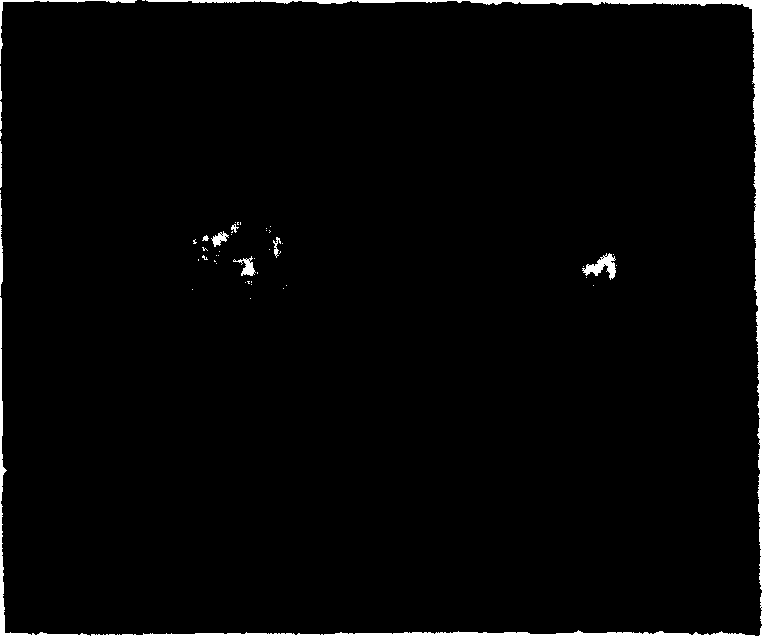Method for micro-propagating tea trees from external leaves plant
A technology for micropropagation and explants, which is applied in the fields of botanical equipment and methods, plant regeneration, and horticultural methods, and can solve problems such as failure to obtain morphogenesis.
- Summary
- Abstract
- Description
- Claims
- Application Information
AI Technical Summary
Problems solved by technology
Method used
Image
Examples
Embodiment 1
[0079] When at 25±2℃ and 52μg / molm -2 the s -1 Reactive explants were cultured in 0.8% agar solidified basic MS supplemented with 3% sucrose and 2.5-10.0 mg / l 2,4-D (pH 5.6 ± 0.2) in the presence of cold fluorescence and under a 16-hour photoperiod of light At 6-10 weeks in culture, in vitro cultured plants of important cultivars (Chinaary, Assamica and Cambod) had fully closed, semi-open or fully opened leaves. Any leaf of the plant was a reactive explant. The callus thus developed after 6-10 weeks was transferred to a medium for rooting or undefined root formation supplemented with 3% sucrose and 0.5-8.0 mg / l 6-benzylaminopurine and 0.1-0.8 mg / l indole -3-butyric acid in 0.8% agar solidified basic MS medium. After 4-10 weeks, the rooted calli were transferred to 0.8% agar-solidified minimal MS medium supplemented with 3% sucrose and 0.5-8.0 mg / l 6-benzylaminopurine for undefined shoot formation. Undefined shoots were excised and placed on 0.8% agar-solidified minimal MS m...
Embodiment 2
[0081] Completely closed, Any leaves of semi-open or fully-open leaf explants were used as explants. The leaves were carefully washed with a black brush and liquid detergent, washed in Tween 20 with (0.1%) carbendazim and (0.05%) streptomycin and chlorinated in 0.01% with one drop of liquid detergent. Surface sterilized in a mercury solution followed by a thorough rinse in distilled water. The sterilized explants were cultured similarly to every detail in the method described above.
Embodiment 3
[0083] When at 25±2℃ and 52μg / molm -2 the s -1 Reactive explants were cultured in 0.8% agar solidified basic MS supplemented with 3% sucrose and 2.5-10.0 mg / l 2,4-D (pH 5.6 ± 0.2) in the presence of cold fluorescence and under a 16-hour photoperiod of light Any leaves from fully closed, semi-open or fully open leaf explants of in vitro cultured plants of other hybrid cultivars such as Tocklai Variety 1 were reactive explants at 6-10 weeks in culture. The callus thus developed after 6-10 weeks was transferred to a medium for rooting or undefined root formation supplemented with 3% sucrose and 0.5-8.0 mg / l 6-benzylaminopurine and 0.1-0.8 mg / l indole- 3-Butyric acid in 0.8% agar solidified with basic MS medium. After 6-10 weeks, the rooted calli were transferred to 0.8% agar-solidified minimal MS medium supplemented with 3% sucrose and 0.5-8.0 mg / l 6-benzylaminopurine for undefined shoot formation. The shoots obtained from the amorphous shoots were propagated for 6 weeks in 20...
PUM
 Login to View More
Login to View More Abstract
Description
Claims
Application Information
 Login to View More
Login to View More - R&D
- Intellectual Property
- Life Sciences
- Materials
- Tech Scout
- Unparalleled Data Quality
- Higher Quality Content
- 60% Fewer Hallucinations
Browse by: Latest US Patents, China's latest patents, Technical Efficacy Thesaurus, Application Domain, Technology Topic, Popular Technical Reports.
© 2025 PatSnap. All rights reserved.Legal|Privacy policy|Modern Slavery Act Transparency Statement|Sitemap|About US| Contact US: help@patsnap.com



